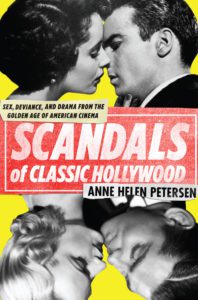
There is always a stubborn gap between one’s authentic self and the stylized representation that constitutes one’s persona. For Hollywood’s early celebrities, that gap was more chasm than crack, better measured in miles than inches. An actor’s image often contained little more than a smidge of reality. Mae West wasn’t chaste or single or 30 years old or French; she was married, 42, polyamorous, and German. Wallace Reid wasn’t acutely sensitive to film’s bright lights but a heroin junkie, and Carol Lombard’s image as a madcap schoolgirl, all giggles and antics, belied her status as one of the canniest negotiators in the industry. A new name, a story of origin, strategic marriages, wardrobe overhauls, speech therapy, calculated casting decisions, and the illusion, at least, of morally upstanding behavior were requisite for Hollywood fame and fortune. They were also celebrity’s Achilles’ heel. The system was infected with a precariousness born of its own devices. Layers upon layers of artificiality made Hollywood success hardly more secure than a house of cards.
A new book by Anne Helen Petersen, Scandals of Classic Hollywood, chronicles the aftermath of high-profile celebrity scandal, focusing on film stars working for major studios roughly between 1910 and 1955, from Mary Pickford to James Dean. An expert in Hollywood history, Petersen is more interested in the mechanics of scandal than its petty grist—not who cheated on whom, but the cultural patterns that govern scandal: how and why it erupts; how it sticks or melts away; how it is finessed and handled; and the murky reasons why the same trespass can strip one star of fame and make another twice as famous. As Petersen describes, scandal is never the problem of immoral behavior it feigns to be, but of information control. An injurious detail has escaped (“got out”), and like a convict on the run, inspires a combination of calm adrenaline and quick strategy: all hands on deck.
Indeed, a scandal in classic Hollywood could turn a celebrity to nothing and run a studio bankrupt. Determined to protect not only their investment in their stars, but the moral reputation of their industry, studios assumed a paternalistic role in the lives of their actor-employees, surveilling private comings and goings and meddling whenever necessary. “Fixers” were the invisible glue of the system who discreetly handled anything untoward that might implode a profitable image. Fixers let another studio employee take the blame and serve jail time when Clark Gable, driving drunk, mowed down a pedestrian. Fixers stepped in to conceal Loretta Young’s out-of-wedlock pregnancy (another Gable oops), shipping the starlet to Europe and arranging for the child to be delivered and put up for adoption by MGM nurses with confidentiality contracts. When cover-ups weren’t an option, fixers switched to damage control. At the height of Jean Harlow’s fame, her husband, Paul Bern, shot himself in the head. MGM fixers were at the scene before the police to ponder the suicide note and brainstorm strategy, eventually “leaking” a story that Bern had killed himself in despair over his supposedly abnormal penis. All went according to plan: Harlow’s reputation came out unsullied.
Scandals of Classic Hollywood is as compulsively readable as Petersen’s popular column for The Hairpin—except, sadly, without the treasure trove of photos. Petersen has a knack for selecting exactly the right examples in exactly the right measure, and moves through them with the pace and panache of a sports broadcaster. The palatable bit of cultural theory with which she bookends each section is so concise and well-ventilated that the reader’s enthusiasm remains not only intact, but nicely edified. Most impressively, Petersen’s glossing of fan magazines leaves the impression, against all probability, that these texts are rich troves of historical meaning.
Be forewarned that despite the salacious connotations of “scandal,” Petersen’s tales are often melancholic, laden with the human pathos that often accompanies worldly success. Relishing the beastly details of someone else’s personal life loses some of its frisson when that person is ruined, forgotten, and dead, and Petersen is unexpectedly sympathetic, refusing to condescend to her subjects’ vanity and excess, able to analyze the spectacle of celebrity abjection without forgetting its core of flesh and blood. Many of Petersen’s subjects come off more victim than star, notably Judy Garland and Dorothy Dandridge, paired in a section titled “Broken By the System.” Both women were gifted celebrity but forbidden a real-life identity, and ultimately suffocated by their Hollywood persona. Well into adulthood, Garland was still trying to shed her image as an ebullient youngster. She longed to be one of the great glamour queens like Lana Turner or Joan Crawford, but instead was doted on as a “little girl” who spoke like a “kindergartener asking her way to the bathroom”—this after her 3rd marriage and 30th birthday. Dandridge also resisted the image thrust upon her, that of a sexed-up Negress. Whereas Garland’s predicament stemmed from a pivotal casting decision in Wizard of Oz and the apparent misfortune of a “large rib cage,” Dandridge was at the mercy of the era’s reductive notions of black women. After the smashing box office success of Carmen Jones and an Academy Award nomination for Best Actress, Dandridge waited for a script that suited her stature, refusing a few minor roles and one major role that cast her as a slave. No script was forthcoming (as it would have been for a white actress of comparable ability), and Dandridge became known around Hollywood as a snob. Her career withered and finally ended with a libelous accusation that she’d rendezvoused with a white man. Given her oversexed persona (her nickname was Heatwave) the public found the story all too plausible, and besides, they’d already judged Dandridge an uppity black woman.
Dandridge’s career followed a similar trajectory as Roscoe “Fatty” Arbuckle’s, which Petersen discusses in an earlier chapter. He was a comedic actor whose appeal hinged on his size. Fatty was fat and funny and fat in a funny way, and then he was accused of rape. In the space of one week, “the highest-paid man in Hollywood, beloved for his physical comedy and chaste, boyish love stories,” writes Petersen, “became the most hated man in America—a rapist, a drunk, and proof that the stars had, indeed, run wild.” His mercurial fans switched from perceiving obesity as comic relief to gross monstrosity, and instantly accepted a syllogism between Fatty’s uncouth appetite for pork chops and an uncouth appetite for sex. The rape accusation was baseless and cursorily dismissed in court, but stuck nonetheless. Fatty’s demise might have been averted had his studio not stood by passively, but here was an opportunity, they realized, to deflect rumors of widespread Hollywood debauchery and let the fat guy take the fall. Fatty, they implied, was one bad apple in a good Hollywood barrel.
Petersen’s peppy language and tendency towards hyperbole are wonderfully deployed in conveying the potent mishmash of yearning, fantasy, sexual thrill, and voyeurism with which the public regales its celebrities—no mean feat when the celebrity in question is so dusty and remote. To understand the power of Marlon Brando, for instance, is to conjure an earlier incarnation of the actor, the creature who, Petersen writes, made film critic Pauline Kael avert her eyes in shame. The first time Kael saw Brando perform, she thought he was having a seizure. Valentino, writes Petersen, was a “live conduit of female desire;” Jean Harlow was “a total dame;” and Clara Bow had “[b]liss written all over her body.” Wallace Reid may no longer be shorthand for sex object extraordinaire, but his magnetism is easily conveyed with an analogy to Brad Pitt’s shirtless debut in Thelma and Louise.
The same writerly tendency, however, occasionally leads Petersen awry. Her summation of Clara Bow’s backstabbing, for example, feels uncharacteristically turgid and overblown. Bow’s best friend and personal assistant publicly accused the actress of two- and three-timing her boyfriends, gifting them outrageously expensive trinkets, and, most outré of all, dying her hair. The courtroom mudslinging and attendant financial disclosures set Bow on a slippery slope of public distaste that culminated in tabloid headlines claiming the actress enjoyed sex with dogs, among other things. Recounting the tale with the surefootedness of a practiced storyteller, Petersen concludes that Bow “ruptured the ideological fabric” and “tore down the conventions of how sexuality and femininity should not mix.” In fact, very little seems to have been ruptured or torn down—Bow, after all, was forced to retire from film, and women who curry sexual favor with many men (“sluts”) continue to induce cultural panic.
Why Petersen should feel compelled to harness a major claim to a minor (though riveting) historical anecdote is a matter of speculation, but her scholarly background—a PhD from the University of Texas and several years on the academic job circuit—is a plausible culprit. (Petersen recently left academia to take a job at BuzzFeed; her blog post explaining the move is worth reading.) If Petersen’s graduate studies made her an expert in Hollywood history and media analysis, they perhaps also imparted a residual defensiveness, an impulse to champion celebrity scandal as crucial, major, and important, rather than, as her stodgy colleagues might have implied, trite, superficial, and feminine. As Petersen writes in her introduction, she aims to “rescue” her subject “from the cultural wastebasket.”
But the allure of Petersen’s material lies in the fact that it escapes this dichotomy completely. Neither “substantive” nor “trivial” adequately characterize the emotional labyrinths of fame and desire that undergird stardom. Celebrity adulation richly suffuses the everyday flotsam of lived experience, and yet belongs to a terrain of human longing that is poorly mapped and poorly understood. We alternately indulge and shame our curiosity, just as we indulge and shame our celebrities, cycling through approval and disapproval, through mean-spirited mockery and heartfelt identification, and never understanding exactly why. On a random day in 1958, the poet Sylvia Plath recorded in her diary the week’s celebrity gossip: “Liv Taylor is getting Eddie Fisher away from Debbie Reynolds, who appears cherubic, round-faced, wronged, in pin curls and house robe—Mike Todd barely cold. How odd these events affect one so. Why?” The question still begs an answer. Happily, Petersen is on the job.





